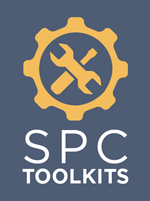Consolidate gains and produce more change.
—John Kotter
Launch More ARTs and Value Streams
This is article 10 in the SAFe® Implementation Roadmap series. Click here to view the entire roadmap.
The previous articles in the Implementation Roadmap series described the first nine ‘critical moves’ of the Implementation Roadmap. They are as follows:
- Reaching the Tipping Point
- Train Lean-Agile Change Agents
- Train Executives, Managers, and Leaders
- Create a Lean-Agile Center of Excellence (LACE)
- Identify Value Streams and Agile Release Trains (ARTs)
- Create the Implementation Plan
- Prepare for ART Launch
- Train Teams and Launch the ART
- Coach ART Execution
Think of this stage as a train picking up steam and moving at an accelerated pace. The larger business opportunity has arrived, enabling the enterprise to “consolidate gains and produce more change” by launching more Agile release trains and value streams [1]. This allows the business to start realizing the fuller benefits of SAFe, effectively shifting to the next higher gear of the transformation.
Details
![]()
As the Implementation Roadmap picture illustrates, and experience has shown, the first Program Increment (PI) Planning event, ART launch, and PI deliverables provide initial, measurable, and substantial business benefits. Business and development are now aligned to a common vision and mission; everyone has agreed to a new way of working and has adopted a common method, language, cadence, and synchronized events; new roles and responsibilities are established; a new level of employee engagement arises as teams take responsibility for planning their own future. And most importantly, the first PI deliverables have illustrated the effectiveness of adopting SAFe and continuously improving the competencies of the Lean Enterprise.
In addition, the first ART creates an effective pattern and the initial institutional ‘muscle memory’ needed to implement additional ARTs in the value stream. In this next critical move—launch more ARTs and value streams —the enterprise can start to realize an even greater return on their investment: faster time-to-market, higher quality, higher productivity, and increased employee engagement. These are the rewards that only a full and effective implementation of scaled Lean-Agile practices can deliver.
Launch More ARTs
By now, SAFe Program Consultants (SPC)s, the Lean-Agile Center of Excellence, and other stakeholders have the experience needed to launch more ARTs in the next selected value stream. After all, the more ARTs, the greater the return. The pattern is the same. Simply repeat the critical moves that worked the first time:
However, a cautionary note is warranted. The same attention and effort must be devoted to the next few ARTs as was paid to the first. Otherwise, there may be a tendency to assume that ‘everyone knows how to do this now.’ That’s unlikely this early in the transformation, and the stakeholders in the lead will need to give as much love and care to each subsequent ART as they did to their first.
Implement Large Solution Roles, Artifacts, and Events
As described in Identify Value Streams and ARTs, some value streams can be realized by a single ART. They already have the people, resources, and cross-functional skills needed to Release on Demand without additional coordination, integration with other ARTs, or added governance.
However, larger value streams require the development of the organization’s Enterprise Solution Delivery competency and some or all of the additional roles, events, and artifacts of the Large Solution SAFe will be required (see Figure 1).
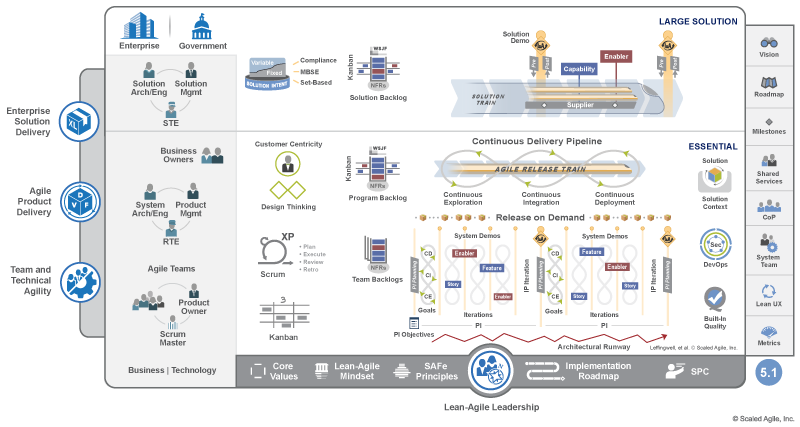
This is also true for high-assurance systems, where more rigor of system definition (Solution Intent) and other activities are likely to be required. In this case, the next stage of the rollout for these value streams will need to establish these additional practices.
Because these responsibilities, artifacts, and activities are new to the enterprise, the leaders, the SPCs, and the LACE will again play an active role. Their tasks may include:
- Establishing roles – Fill the three large solution roles—Solution Train Engineer (STE), Solution Management, and Solution Architect/Engineering.
- Establishing Solution Intent – Determine the responsibilities, process, and tools to define and document Solution Intent. For high-assurance systems, establish and/or evolve Lean-Agile verification and validation practices (see Compliance).
- Establishing a large solution Vision, Roadmap, and Metrics – Many elements of the spanning palette may be required for large value streams. These include vision, roadmap, metrics, Shared Services, System Team, and DevOps strategies, Lean User Experience (UX), Milestones, and releases.
- Introducing Capabilities and the Solution Backlog – Larger value streams benefit from the use of the capabilities backlog item, in which case the Solution Kanban must also be established.
- Implementing Pre- and Post-PI Planning, Solution Demo, and large solution Inspect and Adapt (I&A) – These events are required to prepare for individual ART PI planning, to follow up and coordinate Solution Objectives after planning, and to demonstrate the full solution to stakeholders.
- Integrating Suppliers – Large value streams typically have internal and/or external Suppliers. Whether they are already embracing Lean-Agile and SAFe principles or not, they must be integrated into the new way of working. Lean enterprises often take an active role in helping their suppliers adopt SAFe, as it improves the economics of the larger value stream. Whatever the case, the suppliers must at least be integrated into SAFe events at the large solution level.
Launch More Value Streams
Launching the first full development value stream is a major milestone in the transformation. Outcomes are improving. People are happier. The new way of working is being ingrained into the habits of the organization. The culture is evolving as well.
However, the job is far from done in the large enterprise. The other development value streams may serve entirely different businesses, operating units, or subsidiaries. They may be located in different countries, offer markedly different solutions and services, and have different chains of command that may only converge at the highest corporate level.
As a result, even the spread of good news to other development value streams may not evoke an automatic embrace of SAFe across the enterprise. Many may think, ‘What worked there may not work here.’ So, in a sense, each new development value stream represents the same challenge and opportunity to incorporate all the change management steps described so far. Each new value stream will need to go through the same series of steps that got you to this point, as illustrated in Figure 2.
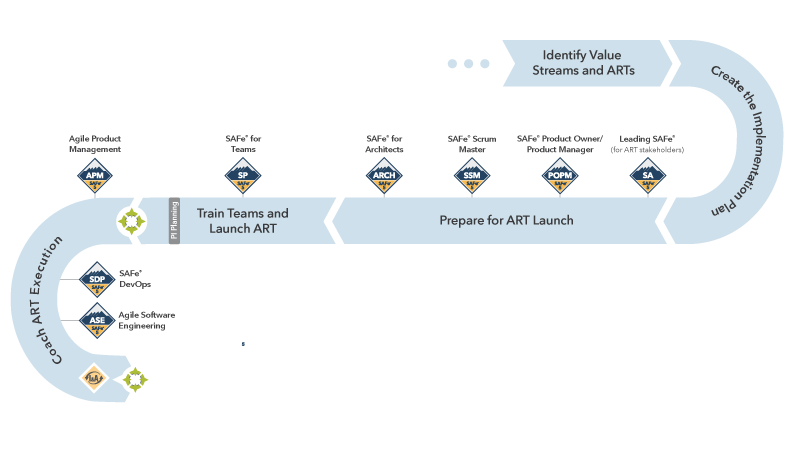
Accordingly, as the enterprise ponders the next big steps—where the change, impact, and business benefits will be the greatest—it’s a good time to roll out the Invitation-Based Implementation Approach. This will help generate the necessary buy-in and will also ‘shape the path’ that allows key stakeholders to assume the leadership roles they will need to succeed in the new way of working [2].
Also, given the scope of the effort ahead, it’s a good time to reflect on earlier principles and apply Principle #6 – Visualize and limit Work in Process (WIP), reduce batch sizes, and manage queue lengths. These principles are illustrated in the SAFe Implementation Railway, described below.
The SAFe Implementation Railway
A while ago a team from Scaled Agile visited the folks at Northwestern Mutual. They were in the midst of one of the larger and most significant SAFe rollouts to date. They spent some time with the technical transformation team (similar to the LACE), sharing experiences and learning from each other. The team showed how they had managed their transformation rollout. The highlight was a 10-foot long Big Visible Information Radiator (BVIR). It was actually really big, as illustrated in Figure 3.
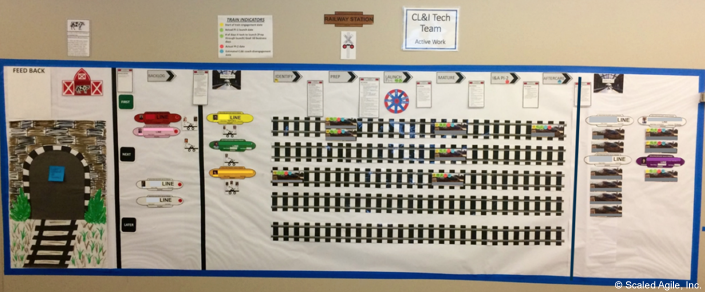
Reproduced with permission of Northwestern Mutual.
Their Lean-Agile Mindset, the way they applied SAFe principles and practices, and the structured way they executed the implementation was so impressive, that they were asked to share their experience with the SAFe community. They graciously agreed. One outcome was that Sarah Scott presented their work as a case study at the 2016 SAFe Summit. Further, those learnings and their experience have been generalized into guidance for the SAFe Implementation Railway, as seen in Figure 4.
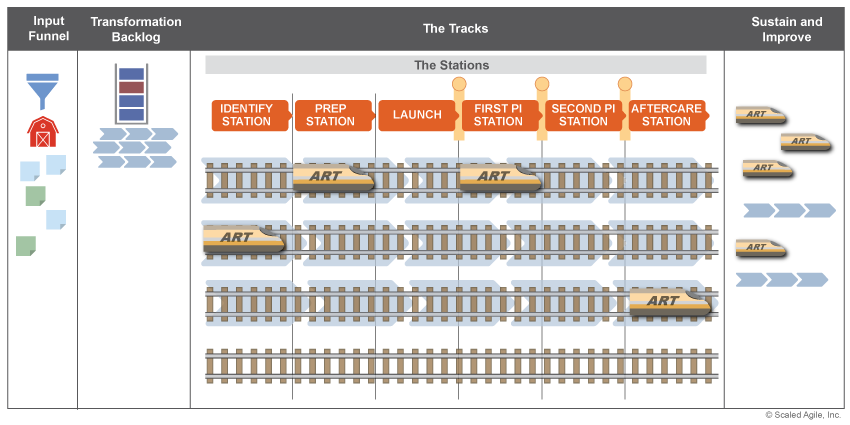
The Four States of the Railway
The railway operates as a Kanban board that contains a series of four major states, with one state, the tracks, having multiple steps for each ART. Each of the four major states is described below.
- Input funnel – Used for numerous purposes, this state’s primary role is to act as an opportunity for stakeholders to volunteer their value streams for transformation. Other purposes include collecting feedback, offering suggestions for improvement or points of discussion, or identifying challenges. In short, whatever is needed. There are no WIP limits for the funnel. When ready, a value stream is pulled into the transformation backlog state.
(Note: At Northwestern Mutual, the funnel state also features the barn, a holding place for a small herd of what they label ‘impediment cows,’ which are explained below.)
- Transformation backlog – The transformation backlog is the to-do state. This is where value streams are prioritized for transformation based on opportunity and support from relevant stakeholders. Value streams stay here until they meet the following exit criteria:
- Leadership prepared – Development value stream stakeholders have been trained in the new way of working, established and communicated a sense of urgency, built the guiding coalition, and developed and communicated the change vision.
- ARTs identified – The operational and development value streams have been analyzed, and prospective ARTs have been identified (see Identify Value Streams and ARTs).
- Development Value Stream Canvas defined – The development value stream itself is further defined and the development value stream canvas is created (see Create the Implementation Plan).
- SPCs trained – In order to provide the knowledge and coaching expertise, additional SPCs in the value stream are trained (see Train Lean-Agile Change Agents). A coaching plan is created.
This state is WIP limited, ensuring adequate LACE and SPC support.
- The tracks – The tracks represent the doing state, where the ARTs are structured, launched, and operated to achieve the aim of the development value stream. There are five intermediate stations on this track, described below. The tracks are WIP limited in two ways: there are only a small number of tracks (value streams) available, and there can be no more than ‘X’ trains on each track.
- Sustain and improve – Once an ART can run independently, without the constant attention of coaches, the train is moved to the sustain and improve state on the BVIR. This section displays all the SAFe value streams and ARTs in the organization that have been launched to date. This state is not WIP limited; the more the merrier!
As the name indicates, the arrival of each train at the sustain and improve state is not the end of its journey. It’s only a milepost. Once it arrives, each train’s relentless improvement journey begins. In fact, as of version 5.0 of SAFe, this final state has been renamed to “Accelerate” with new guidance and tools to Measure & Grow using self-assessments that can help diagnose where the organization is in its adoption of SAFe along 7 competencies and 21 dimensions. This is consistent with the value of Relentless Improvement that has long been part of the foundation of SAFe.
The Tracks
The tracks are where most of the transformational work takes place. Each station on the track represents a state of maturity for an ART. While the number and definition of the stations can be adapted to each enterprise’s context, Figure 5 offers one example:
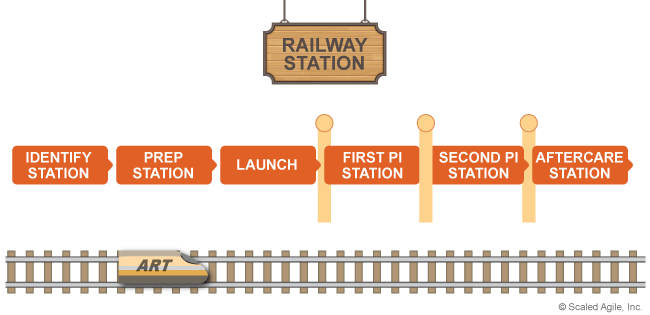
The stations are as follows:
- Identify station – (See Create the Implementation Plan) This station includes the following types of work:
- Communication of the change vision
- Identifying trains using the ART canvas
- Preparing for the first ART launch, including setting the date for PI planning
- Scope and structure of the ART is determined, and the needed practitioners are identified
- Establishing a training plan
Data captured: number of practitioners in each ART, including the PI cadence (start and end date) for each ART
- Preparation station – (See Prepare for ART Launch) Typical activities include:
- Defining the ARTs
- Organizing teams into feature and component teams
- Performing Leading SAFe training
- Training Product Owners, Product Managers, and Scrum Masters
- Assessing and evolving launch readiness
- Preparing the program backlog
Data captured: the PI cadence (start and end date) for each ART, the number of people trained for each role
- Launch station – (See Train Teams and Launch the ART) Typical activities include:
- Conducting SAFe for Teams training
- Conducting the first PI planning event
Data captured: date of first PI planning, the total time (cycle time) for a train in this state
- First PI station – (See Coach ART Execution) Typical activities include:
- Coaching the ART
- Finalizing establishment of roles, including any specialty training required
- Executing the first PI
- Conducting the first System Demo
- Holding the first I&A workshop
- Reinforcing the Lean-Agile mindset and SAFe principles
- Ensuring successful events
Data captured: start and end date for each ART, estimated date of second PI planning event, estimated coaching end date, first PI predictability measure
- Second PI station – (See Coach ART Execution) Typical activities include:
- Observing improvement items from first I&A
- Completing the second I&A workshop
- Assessing PI predictability and other relevant objective measures
- Observing and coaching self-managing and self-improving behaviors
- Assessing progress toward a relentless-improvement mindset
- Observing significant events, including system demo, and ensuring that events are occurring on a regular cadence
- Observing next PI planning event
Data captured: PI predictability measure, PI performance metrics, date of the second PI planning event
- Aftercare station – (See Coach ART Execution) The aftercare station timing is a little more subjective, but it usually occurs after two to four PIs. Typical activities and measures include:
- PI predictability achieving target zone (80–100 percent)
- Planning future coaching needs
- Exhibiting self-reflection and relentless improvement
Data captured: start and end date for each ART in this state, PI predictability measures
Managing Impediments
The above plan seems straightforward, assuming the training, change management, and cultural underpinnings are all there. But many impediments will naturally occur during the rollout. In their own words, here’s how Northwestern Mutual had some fun with their series of challenges:
The impediment cow – “It’s important to include your organization’s culture into the transformation. One key aspect of our culture was an impediment, which we call a ‘cow on the tracks’ [see Figure 6].”
The backstory of the cow – “In 1859, two Northwestern Mutual policy owners were killed when a train hit a cow and derailed. A tragedy for sure. First death claims totaled $3,500. But the company had only $2,000 on hand. President Samuel Daggett personally borrowed the funds needed to cover the remaining balance, which was the inception of our focus on doing what’s right for policy owners. Now whenever there is a significant challenge or impediment, people might say, Lookout, there is a cow on the track!”
“In the context of both Northwestern Mutual and SAFe, whenever a train was facing a major problem, we took a cow out of the barn and placed it on the track. It was obvious, fun, and reinforced our culture. Most importantly, it immediately drew attention to the problem.”
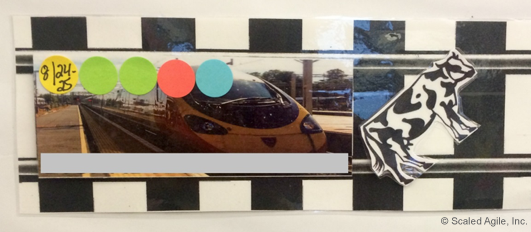
Image courtesy of Northwestern Mutual. Source of the cow: www.vectorportal.com
Moving Forward
Clearly, this portion of the roadmap represents the largest amount of work in a successful SAFe implementation. It requires leadership, urgency, persistence, and actively removing impediments. As the culture starts to shift to the new values and norms, patience is also essential.
With value streams and trains now running on a consistent basis, it’s time to move on to the next critical move in the SAFe Implementation Roadmap: Extend to the Portfolio.
NextLearn More
[1] John P. Kotter. Leading Change. Harvard Business Review Press, 1996. [2] Heath, Chip, and Dan Heath. Switch: How to Change Things When Change Is Hard. Crown Publishing Group, 2010.Additional Resources
- Leading SAFe with SA certification
- SAFe Scrum Master with SSM certification
- SAFe Product Manager/Product Owner with POPM certification
- SAFe for Teams with SP certification
Last update: 27 September 2021





